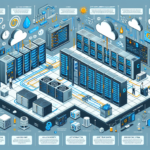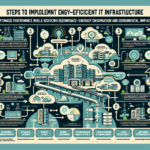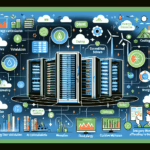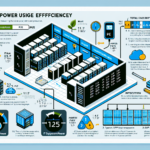Reducing cooling costs in a datacenter is a critical objective for optimizing operational efficiency and sustainability. As an IT manager responsible for datacenter operations, here are several strategies you can implement to reduce cooling costs:
1. Optimize Airflow Management
- Seal Gaps and Leaks: Use blanking panels in server racks to prevent hot and cold air from mixing. Seal any gaps or leaks in raised floors and ducts.
- Hot/Cold Aisle Containment: Implement hot/cold aisle configurations to segregate hot exhaust air from cold intake air, improving cooling efficiency.
- Install Airflow Management Tools: Use air curtains, containment systems, or baffles to direct airflow precisely where needed.
- Monitor Airflow Patterns: Regularly audit airflow patterns with Computational Fluid Dynamics (CFD) modeling to identify inefficiencies.
2. Increase Temperature Setpoints
- Raise Temperature Thresholds: Modern servers and IT equipment can operate efficiently at higher temperatures. Consider increasing the datacenter temperature setpoints (e.g., from 20°C to 25°C) within ASHRAE guidelines to reduce cooling requirements.
- Use Economizers: Leverage outside air when ambient temperatures are cool enough to meet cooling requirements (air-side or water-side economizers).
3. Upgrade to Energy-Efficient Cooling Systems
- Adopt Variable Speed Drives (VSDs): Use VSDs in fans, pumps, and chillers to adjust cooling capacity dynamically based on demand.
- Replace Legacy Cooling Systems: Upgrade to more efficient cooling systems like liquid cooling, evaporative cooling, or in-row cooling.
- Install Thermal Storage: Incorporate thermal storage systems to shift cooling loads to off-peak hours, reducing energy costs.
4. Implement Monitoring and Automation
- Use DCIM Software: Deploy Datacenter Infrastructure Management (DCIM) tools to monitor temperatures, humidity, and cooling performance in real-time.
- Automated Cooling Controls: Implement smart cooling systems that adjust dynamically based on workload and environmental conditions.
- Temperature Sensors: Install temperature sensors throughout the datacenter to identify hotspots and optimize cooling distribution.
5. Virtualization and Consolidation
- Server Consolidation: Virtualize workloads and consolidate servers to reduce the number of physical machines, thereby lowering heat generation.
- Decommission Unused Equipment: Identify and retire outdated or idle equipment that contributes to cooling load.
6. Utilize Free Cooling
- Leverage Natural Cooling: If your datacenter is in a region with a favorable climate, consider using free cooling methods (e.g., air-side economizers or direct/indirect evaporative cooling).
- Cold Climate Locations: If feasible, relocate datacenters to colder climates to benefit from lower ambient temperatures.
7. Optimize Rack and Equipment Layout
- Rack Density: Avoid overloading individual racks with high-density equipment; distribute workloads evenly.
- Cable Management: Organize cabling to prevent airflow obstructions and hotspots.
- Spacer Racks: Add spacer racks to improve airflow and reduce cooling strain.
8. Implement Liquid Cooling
- Liquid Cooling Systems: Adopt liquid cooling technologies such as immersion cooling or direct-to-chip cooling for high-density workloads (e.g., GPU workloads for AI and ML).
9. Renewable Energy Integration
- Solar Panels and Wind Energy: Explore renewable energy sources to power cooling systems and offset electricity costs.
- Energy Storage: Use energy storage systems to reduce reliance on the grid during peak cooling loads.
10. Regular Maintenance
- Clean HVAC Systems: Ensure cooling units, filters, and heat exchangers are cleaned regularly to maintain efficiency.
- Inspect Equipment: Periodically inspect cooling systems, fans, and pumps to ensure they are functioning optimally.
11. Consider AI and Machine Learning
- AI Optimization: Use AI-powered cooling management systems to predict heat load and optimize cooling dynamically.
- Workload Placement: Leverage AI to distribute workloads across servers to minimize localized hotspots.
12. Design for Efficiency
- Modular Datacenter Design: Consider modular datacenter designs for scalability and optimized cooling efficiency.
- Passive Cooling: Explore passive cooling techniques such as thermal conduction or radiant cooling for specific workloads.
13. Evaluate Energy Efficiency Metrics
- PUE Improvement: Focus on improving Power Usage Effectiveness (PUE) by minimizing non-IT energy consumption.
- Cooling Metrics: Measure cooling system efficiency regularly to identify areas for improvement.
By implementing these strategies, you can reduce cooling costs while maintaining optimal performance for IT infrastructure, servers, storage, AI workloads, and other critical systems in your datacenter.
How do I reduce cooling costs in a datacenter?




